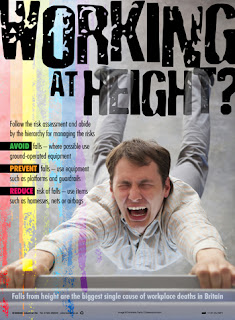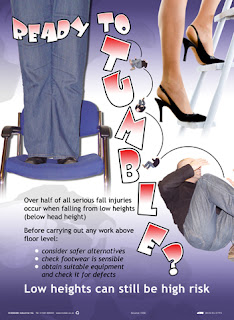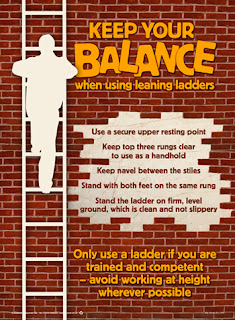 |
| 1 |
 |
| 2 |
 |
| 3 |
Every week I read stories about workers who have fallen from height and have been killed or seriously injured as a result.
Working at height is a risk in itself and should be avoided wherever possible. When there is no other alternative, the task should be properly risk assessed and appropriate safety measures should be taken.
So why do so many accidents still happen, and what are the most common mistakes when working at height?
Underestimating the risks
Falls from height are the biggest single cause of workplace deaths in Britain. Workers should be fully aware of the seriousness of the risks involved and how to manage them.
Falls from height are the biggest single cause of workplace deaths in Britain. Workers should be fully aware of the seriousness of the risks involved and how to manage them.
Thinking that the only way is up
It is not always the case that work has to be carried out at height. Ground-operated equipment should be used wherever possible.
It is not always the case that work has to be carried out at height. Ground-operated equipment should be used wherever possible.
Thinking that anyone can do it
Working at height is a skilled operation that should only be attempted by trained and competent staff who have the confidence to do so.
Working at height is a skilled operation that should only be attempted by trained and competent staff who have the confidence to do so.
Thinking that low height is low risk
It isn't. More than half of all serious fall injuries occur when falling from low height (below head height). For example,HSE statistics show that around 2000 workers are seriously injured every year after falling from vehicles.
It isn't. More than half of all serious fall injuries occur when falling from low height (below head height). For example,HSE statistics show that around 2000 workers are seriously injured every year after falling from vehicles.
Using unsuitable platforms
Platforms must be secure, sturdy, stable and strong enough to support the weight of the worker. Fragile roofs and unsecured platforms can cave in or tip over when weight is applied.
Platforms must be secure, sturdy, stable and strong enough to support the weight of the worker. Fragile roofs and unsecured platforms can cave in or tip over when weight is applied.
Not doing enough to prevent falls
If working at height is the only option, safety precautions such as barriers and guardrails should be in place before work begins.
If working at height is the only option, safety precautions such as barriers and guardrails should be in place before work begins.
Not doing enough to reduce the risk of falls
Harnesses, nets and airbags can reduce the impact of a fall if other safety precautions should fail.
Harnesses, nets and airbags can reduce the impact of a fall if other safety precautions should fail.
Using ladders incorrectly
Ladders should only be used by trained and competent members of staff, when there is no safer alternative.
Ladders should only be used by trained and competent members of staff, when there is no safer alternative.
Kodiak's motivational poster programme regularly covers various aspects of working at height.
If you would like more information about how our posters can help your company to manage the risks, please do not hesitate to contact us.
For daily tips on dealing with common workplace issues, why not follow us on Twitter.
If you would like to find out how Kodiak posters
can help your business work smoother, smarter
and safer, please call us on: 01530 456 000
or email us.

No comments:
Post a Comment